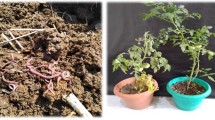Abstract
The presence of Palmer amaranth (AMAPA) residues in the soil reduced fresh weight accumulation in onions and carrots and markedly decreased seedling field establishment of carrots. Solid-phase separation techniques were used to isolate fractions containing water-soluble organic compounds from AMAPA residues and soil amended with such residues. At concentrations of 20–100 mg/liter most of the organic solids thus extracted were inactive in seed germination assays using onion, carrot, AMAPA, and tomato seeds. Extracts from the roots of AMAPA increased 72-hr germination percentages in carrot, AMAPA, and tomato. A time-study of AMAPA residue decomposition in soil showed an increase in extractable inhibitors of onion germination after 62 days but no other significant changes in the activity. The most active allelochemicals from AMAPA proved to be volatile compounds. Volatiles emitted by soil containing AMAPA residues and by the dried and partially rehydrated leaf and flower residues themselves reduced carrot and tomato seed germination to less than 7%. Freshly harvested aerial AMAPA inhibited only carrot seed. Germination of AMAPA and carrot seeds was retarded by exposure to volatiles from dried AMAPA residues. Residues from AMAPA grown in Texas and Louisiana exhibited comparable inhibitory activity after air-drying two weeks. Onion seeds were also inhibited by volatiles from AMAPA residues.
Similar content being viewed by others
References
Barnes, J.P., andPutnam, A.R. 1983. Rye residues contribute weed suppression in no-tillage cropping systems.J. Chem. Ecol. 9:1045–1058.
Bedford, L.V., andMackay, D.B. 1973. The value of laboratory germination and weight measurement in forecasting emergence of onion and carrot seed in the field.J. Nat. Inst. Agric. Bot. 13:50–62.
Bhowmik, P.C., andDoll, J.D. 1982. Corn and soybean response to allelopathic effort of seed and crop residues.Agron. J. 74:601–606.
Bhowmik, P.C., andDoll, J.D. 1983. Growth analysis of corn and soybean response to allelopathic effects of week residues at various temperatures and photosynthetic photon flux densities.J. Chem. Ecol. 9:1263–1280.
Bhowmik, P.C., andDoll, J.D. 1984. Allelopathic effects of annual weed residues on growth and nutrient uptake of corn and soybeans.Agron. J. 76:383–388.
Bieber, G.L., andHoveland, C.S. 1968. Phytotoxicity of plant materials on seed germination of crownvetch,Coronilla varia L..Agron. J. 60:185–188.
Bradow, J.M. 1985. Germination required byAmaranthus palmeri andAmbrosia artemisiifolia, pp. 285–299,in A.C. Thompson (ed.). The Chemistry of Allelopathy: Biochemical Interactions Among Plants, ACS Symposium Series No. 268. American Chemical Society, Washington, D.C.
Currah, I.E. 1978. Plant uniformity at harvest related to variation between emerging seedlings.Acta Hortic. 72:57–68.
Del Moral, R., andMuller, C.H. 1970. The allelopathic effects ofEucalyptus camaldulensis.Am. Midl. Nat. 83:254–282.
Evenari, M. 1949. Germination inhibitors.Bot. Rev. 15:153–194.
Fischer, N.H., andQuijano, L. 1985. Allelopathic agents from common weeds:Amaranthus palmeri, Ambrosia artemisiifolia and related weeds, pp. 133–148,in A.C. Thompson (ed.). The Chemistry of Allelopathy: Biochemical Interactions Among Plants, ACS Symposium Series No. 268. American Chemical Society, Washington, D.C.
French, R.C., andLeather, G.R. 1979. Screening of nonanal and related volatile flavor compounds on the germination of 18 species of weed seed.J. Agric. Food. Chem. 27:828–832.
Gressel, J.B., andHolm, L.G. 1964. Chemical inhibition of crop germination by weed seeds and the nature of inhibition byAbutilon theophrasti.Weed Res. 4:44–53.
Guenzi, W.D., andMcCalla, T.M. 1962. Inhibition of germination and seedling development by crop residues.Proc. Soil Soc. Am. 26:456–458.
Guenzi, W.D., McCalla, T.M., andNorstadt, F.A. 1967. Presence and persistence of phytotoxic substances in wheat, oat, corn, and sorghum residue.Agron. J. 59:163–165.
Heisey, R.M., andDelwiche, C.C. 1983. A survey of California plants for water extractable and volatile inhibitors.Bot. Gaz. 144:382–390.
Heisey, R.M., andDelwiche, C.C. 1984. Phytotoxic volatiles fromTrichostema lanceolatum (Labiatae).Am. J. Bot. 71:821–828.
Holm, R.E. 1972. Volatile metabolites controlling germination in buried weed seeds.Plant Physiol. 50:293–297.
Kaminsky, R., andMuller, W.H. 1977. The extraction of soil phytotoxins using a neutral EDTA solution.Soil Sci. 124:205–210.
Katsin, N., Ikan, R., andHalevy, A. 1977. Effect of substituted cyclopentenones and cyclopentanones on lettuce seed germination and radicle growth.J. Agric. Food Chem. 25:1426–1427.
Kimber, R.W.L. 1967. Phytotoxicity from plant residues. I. The influence of rotted wheat straw on seedling growth.Aust. J. Agric. Res. 18:361–374.
Kimber, R.W.L. 1973. Phytotoxicity from plant residues. II. The effect of time of rotting of straw from some grasses and legume on the growth of wheat seedlings.Plant Soil 38:347–361.
McCalla, T.M., andDuley, F.L. 1949. Stubble mulch studies: III. Influence of soil microorganisms and crop residues on the germination, growth and direction of root growth of corn seedlings.Proc. Soil Sci. Soc. Am. 14:196–199.
McCalla, T.M., andHaskins, F.A. Phytotoxic substances from soil microorganisms and crop residues.Bacteriol. Rev. 28:181–207.
Menges, R.M. 1985. Allelopathy of soil residues ofAmaranthus palmeri S. Wats.Annu. Meet. Weed. Sci. Soc. Am. p. 61 (abstract).
Michel, B.E. 1983. Evaluation of the water potentials of solutions of polyethylene glycol 8000, both in the absence and presence of other solvents.Plant Physiol. 72:66–70.
Patrick, Z.A., Tousson, T.A., andSnyder, W.C., 1963. Phytotoxic substances in arable soils associated with decomposition of plant residues.Phytopathology 53:152–161.
Sokal, R.R., andRohlf, F.J. 1981. Biometry. W.H. Freeman, San Francisco, 859 pp.
Vokou, B., andMargaris, N.S. 1982. Volatile oils as allelopathic agents, pp. 59–72,in N. Margaris, A. Koedari, and D. Vokou (eds.). Aromatic Plants: Basic and Applied Aspects. Martinus Nijhoff, The Hague.
Author information
Authors and Affiliations
Additional information
Names of companies or commercial pruducts are given solely for the purpose of providing specific information; their mention does not imply recommendation or endorsement by the U.S. Departemnt of Agriculture over others not mentioned.
Rights and permissions
About this article
Cite this article
Bradow, J.M., Connick, W.J. Allelochemicals from palmer amaranth,Amaranthus palmeri S. Wats. J Chem Ecol 13, 185–202 (1987). https://doi.org/10.1007/BF01020362
Received:
Accepted:
Issue Date:
DOI: https://doi.org/10.1007/BF01020362




